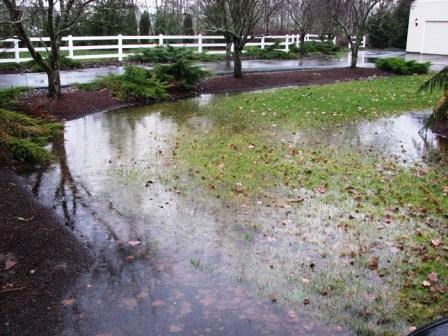If your yard dries out within a day or two after a rainstorm, that is considered normal. A yard with a wetness problem has puddles or soggy areas that persist for several days after storms or are always present.
If you have heavy flows of stormwater passing over your property during storms, but not persistent sogginess afterwards, please see Control Heavy Runoff.
My Yard is Wet for Several Days After Rain or Snow
Wet areas that persist for several days after rain or snow are commonly caused by improper grading (low spots or depressions) or poor infiltration of water into the soil.
- Grading problems on your property will prevent water from quickly flowing away into a storm drain or other suitable outlet. Areas around the foundation should slope away from the foundation walls; swales or other flow diversions between neighboring houses should be properly graded so that runoff does not stagnate on your property.
- Poor infiltration (also known as percolation) can be caused by compacted soils, soil with high clay content or soils with a shallow depth to bedrock. Water can perch on top of these materials, either at the ground surface or slightly below it, causing sogginess. In addition to the solutions below, consider amending the soil.
 Small Wet Area After Storms
Small Wet Area After Storms
In small wet areas after storms, poor grading prevents stormwater from flowing off the yard. Instead, stormwater is held in small, well-defined depressions until evaporation or infiltration into the soil eliminates the wetness.
A practical and environmentally beneficial option is to replant the wet area with water-tolerant plant species, preferably native. If you wish to eliminate the soggy depression, you can do so by filling or re-grading the depression.
1. Replant with water-tolerant species.
A soggy spot can be improved by replanting with water-tolerant plants. Plants will aesthetically improve the soggy spot, soak up the remaining water, attract beneficial pollinators, and they can also slowly improve drainage by loosening the soil with their roots and organic matter.
2. Fill in the depression.
To eliminate wetness in small depressions, the depression can be filled in and graded. Here's how:
- Remove all leaves, plants (including grass) and other loose material from the depression.
- Fill the depression with topsoil (or if near the foundation of the house, with fill soil) and compact using a tamper or a similar device. Use soil with relatively high clay content.
- Grade the filled-in depression so that water will not stagnate. Soil should be graded so that water flows away from the foundation walls to prevent any water damage.
- Cover the depression with sod, grass seeds or other vegetation. If sod is used, make sure the final elevation does not cause water to collect on the up-slope side. If grass seeds are used, consider protecting the seeds with a thin layer of topsoil (approximately ¼ of an inch) followed by a thin layer of straw. This thin layer of soil and straw will help protect the seeds from birds and also enhance germination.
 Widespread Wetness After Storms
Widespread Wetness After Storms
Widespread sogginess near landscaping that is too large or difficult to simply fill in, re-grade or replant, there are other solutions. Runoff can be redirected or captured to minimize water accumulation.
- Redirecting runoff safely takes it to a suitable area. This can be done using swales, French drains, catch basins or downspout extensions.
- Capturing and storing runoff helps protect streams and rivers and reuses the water. This can be done using rain barrels, cisterns, dry wells, soil amendment or rain gardens.
Learn how to redirect runoff and how to capture and store runoff. »
My Yard Is Wet For Months At A Time Or All The Time
Wet areas that last for months or are always present are commonly caused by leaks from damaged water pipes or other sources or naturally occurring high groundwater.
- Groundwater that is naturally close to the surface can also cause wet conditions. High groundwater is generally found in low lying parts of the landscape, especially in floodplains next to perennial streams, and water seepage can also be found on slopes from natural springs. Wetness and puddles in this scenario may not be as closely associated with rainfall. Groundwater is closest to the surface in colder months, but wetness can occur throughout the year.
- Leaky water pipes, lawn sprinkler systems, outdoor faucets, ponds, pools, fountains or other damaged water-related features can be a cause for yards that are always wet. Be aware that the actual source of the wetness may not be at the same place where you see wetness on the surface. You may need to investigate carefully to find the true source of your wetness problem.
 Small Wet Area All the Time »
Small Wet Area All the Time »
- Leaky pipe: How to tell and who to call.
- Natural spring: redirect or capture spring water
 Large Wet Area for Months or All the Time »
Large Wet Area for Months or All the Time »
- Is it a wetland or Resource Protection Area? Follow all laws, rules and guidelines.
- Replant with water-loving species.

